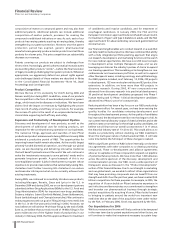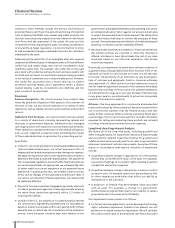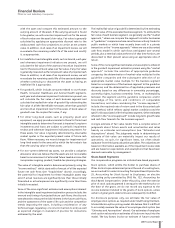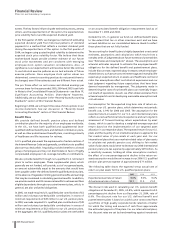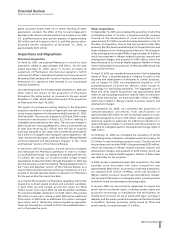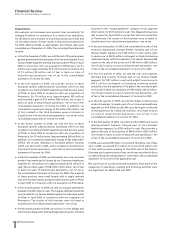Pfizer 2005 Annual Report Download - page 15
Download and view the complete annual report
Please find page 15 of the 2005 Pfizer annual report below. You can navigate through the pages in the report by either clicking on the pages listed below, or by using the keyword search tool below to find specific information within the annual report.
14 2005 Financial Report
Financial Review
Pfizer Inc and Subsidiary Companies
Human Health — Selected Product
Descriptions
•Lipitor, for the treatment of elevated cholesterol levels in the
blood, is the most widely used treatment for lowering
cholesterol and the best-selling pharmaceutical product of any
kind in the world reaching over $12 billion in sales in 2005, an
increase in worldwide sales of 12% compared to 2004. Despite
the substantial growth in 2005, Lipitor performance has slowed,
particularly in the second half of 2005. This performance reflects
a slowdown in the lipid-lowering market as a whole and
increased competition. Despite this market slowdown, Lipitor
still accounts for more than 39% of all lipid-lowering
prescriptions, more than 2.5 times larger than its nearest
competitor. Lipitor will face competition in the U.S. from
generic pravastatin (Pravachol) beginning in April 2006 and
generic simvastatin (Zocor) beginning in June 2006. While we
cannot predict what will happen in any specific market, we have
found that in certain European countries, Lipitor has continued
to grow despite the introduction of generic simvastatin.
In September 2005, the FDA approved the use of Lipitor to
reduce the risk of stroke and myocardial infarction in patients
with type 2 diabetes and multiple risk factors for coronary heart
disease. The FDA’s decision was based on the findings of the
Collaborative Atorvastatin Diabetes Study (CARDS), a landmark
trial of more than 2,800 patients with type 2 diabetes, near-
normal cholesterol, and at least one other risk factor, such as high
blood pressure or smoking. CARDS showed that patients using
Lipitor experienced 48% fewer strokes than those on placebo.
The CARDS study’s steering committee stopped the trial nearly
two years earlier than planned because of the clinical benefits
among patients who took Lipitor.
In addition, the FDA expanded the Lipitor label to include
data on the reduction in the incidence of stroke in patients with
multiple risk factors, as shown in the Anglo-Scandinavian
Cardiac Outcomes Trial (ASCOT) clinical trial. The ASCOT trial
found that Lipitor reduced the relative risk of stroke by 26%
compared to placebo. The study involved people with normal
or borderline cholesterol and no prior history of heart disease
with controlled high blood pressure and at least three other risk
factors for heart disease, such as family history, age over 55,
smoking, diabetes, and obesity. Patients with multiple risk
factors, including diabetes, face a greater threat of heart attack
and stroke. Reducing their risk of such cardiovascular events is
extremely important.
In March 2005, the Treating to New Targets (TNT) clinical study/
trial was presented at the American College of Cardiology
meeting and was published simultaneously in the New England
Journal of Medicine. TNT was the first large-scale study to
show that patients with established coronary disease who
reduce and maintain their cholesterol with Lipitor well below
currently recommended levels experience significantly fewer
heart attacks and strokes than those who lower their cholesterol
to recommended levels. The results of TNT, the longest and
largest study to date of Lipitor 80 mg efficacy and safety, were
achieved safely and build upon the well-established safety
profile of Lipitor’s highest dose. Over the course of the following
eight months, a total of eight TNT sub-group analyses were
presented at the scientific sessions of the American Heart
Association and American Diabetes Association, further
demonstrating the efficacy and safety of long-term therapy with
Lipitor 80 mg in specific patient populations.
The recently published IDEAL study, involving 8,888 patients
with established coronary heart disease, assessed the efficacy
of Lipitor 80 mg for secondary prevention of cardiovascular
events compared with simvastatin (Zocor) 20/40 mg. On the
primary endpoint, reduction in the risk of a major coronary
event, Lipitor 80 mg achieved an 11% risk reduction compared
with simvastatin 20/40 mg. This difference fell short of statistical
significance, however (p=0.07 vs. significance at p=0.05). Lipitor
achieved statistically significant improvements in major
secondary endpoints compared with simvastatin, including a
13% reduction in major cardiovascular events and a 17%
reduction in non-fatal heart attacks.
In December 2005, the U.S. District Court for the District of
Delaware determined that two U.S. patents covering atorvastatin,
the active ingredient in Lipitor, are valid and infringed by the
product of generic manufacturer Ranbaxy Laboratories Limited,
thus protecting Lipitor’s exclusivity until June 2011. In addition,
in October 2005, the United Kingdom’s High Court of Justice
upheld the exclusivity of the basic patent covering atorvastatin.
The ruling prevents Ranbaxy from introducing a generic version
of atorvastatin in the U.K. until the patent expires in November
2011. Both the U.S. and the U.K. decisions have been appealed.
(See Notes to Consolidated Financial Statments—Note 18. Legal
Proceedings and Contingencies.)
•Norvasc is the world’s most-prescribed branded medicine for
treating hypertension. It achieved a 5% growth in sales in
2005 compared to 2004, despite patent expirations in many
European Union (E.U.) countries. Norvasc maintains exclusivity
in many major markets globally, including the U.S., Japan,
Canada and Australia.
In January 2006, the U.S. District Court for the Northern District
of Illinois upheld Pfizer’s U.S. patent covering amlodipine
besylate, the active ingredient in Norvasc, which had been
challenged by the generic manufacturer Apotex Inc. The
decision is subject to possible appeal. (See Notes to Consolidated
Financial Statements—Note 18, Legal Proceedings and
Contingencies.)
•Zoloft, which will lose U.S. market exclusivity in June 2006, is
the most-prescribed antidepressant in the U.S. It is indicated for
the treatment of major depressive disorder, panic disorder,
obsessive-compulsive disorder (OCD) in adults and children,
post-traumatic stress disorder (PTSD), premenstrual dysphoric
disorder (PMDD) and social anxiety disorder (SAD). Zoloft is
approved for acute and long-term use in all of these indications,
with the exception of PMDD. It is the only approved agent for
the long-term treatment of PTSD and SAD, an important
differentiating feature as these disorders tend to be chronic.
In the U.S., in February 2005, Pfizer implemented FDA
instructions that require the makers of all currently marketed
antidepressants, including tricyclic agents, monoamine oxidase
(MAO) inhibitors, selective reuptake inhibitors such as Zoloft,
selective norepinephrine reuptake inhibitors and atypical
antidepressants, to include a black-box warning that
antidepressants increased the risk of suicidal thinking and
behavior in children and adolescents in pooled, short-term
studies. In the nine completed clinical trials of Zoloft involving
children and adolescents, which included studies of Zoloft in
children diagnosed with depression, OCD, or both, no suicides
occurred. The trials found no statistically significant differences


